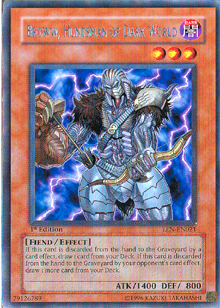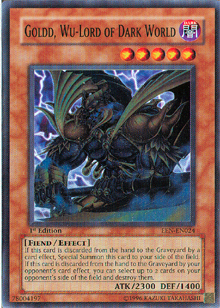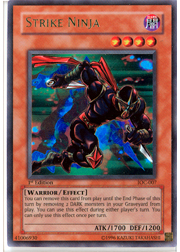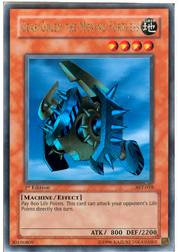I live for tech. Maybe I’ve been listening to a little too much Kanye West lately, but when it comes to silver bullets, “I don’t like it unless it’s brand new.” Like most Shonen Jumps, San Francisco has in no way disappointed my primal need for new single-card strategies. Here are my top picks of the big new cards today.
 Broww, Huntsman of Dark World: In a nutshell, some duelists used to side deck Electric Snake for particularly aggressive control matchups. It did a good job of evening out hits from Don Zaloog or Spirit Reaper, but the problem was that it didn’t really do much else.
Broww, Huntsman of Dark World: In a nutshell, some duelists used to side deck Electric Snake for particularly aggressive control matchups. It did a good job of evening out hits from Don Zaloog or Spirit Reaper, but the problem was that it didn’t really do much else.
Broww has replaced Electric Snake in this role, because it’s a far more versatile card. It gets you an extra draw if discarded by your own Card Destruction or Morphing Jar, Thought it’s matched in its potential synergy with Chaos Sorcerer (Broww is a Darkness monster while the Snake is a Light, so each can be removed from play for Sorcerer’s summoning condition), Broww’s Fiend-type status makes it marginally more synergistic since it can be removed from play to bring out Dark Necrofear in a Fiend deck.
Most importantly, Broww is a lot bigger than the Snake in the stats department. While 1400 ATK is nothing to write home about, it’s undeniably better than the 800 ATK that the Snake is packing. While Electric Snake gets slapped around by Mystic Swordsman LV2, Sangan, and Exiled Force, Broww can at least stand up to those and other weenie monsters. In addition, it’s big enough to trade with Don Zaloog and it packs a decent wallop when it’s attacking directly. Though its worth is a point of contention for some, you can expect Broww to become a side deck staple in the minds of many duelists over the coming weeks.
 Goldd, Wu-Lord of Dark World: Goldd is seeing a lot of use as a main deck splash—way more than I anticipated. Duelists are running one or two copies in order to threaten Control players, and while the actual odds of discarding a single copy of Goldd to a Reaper or Zaloog hit are slim, the card definitely carries a psychological weight. Seeing it hit the table, even as a slightly underpowered tribute monster, has been enough to make some players side deck out their hand control cards for the second game.
Goldd, Wu-Lord of Dark World: Goldd is seeing a lot of use as a main deck splash—way more than I anticipated. Duelists are running one or two copies in order to threaten Control players, and while the actual odds of discarding a single copy of Goldd to a Reaper or Zaloog hit are slim, the card definitely carries a psychological weight. Seeing it hit the table, even as a slightly underpowered tribute monster, has been enough to make some players side deck out their hand control cards for the second game.
In addition, a single copy of Goldd can be good tech in the Dark World matchup, where the opponent is very likely to blast your hand with Card Destruction and Morphing Jar. While a Dark World deck can go off and drop several extra monsters with a well-timed Destruction or Jar, the Dark World player won’t get the second effects of Goldd or Sillva if they controlled the source of the discard: the opponent would. That rationale has duelists splashing Goldd into everything from Beatdown to Soul Control.
 Strike Ninja: Seeing Strike Ninja today was like seeing a celebrity from my childhood. Like seeing Captain Kangaroo out of costume at a shopping mall, but with a heightened atmosphere of general stabbiness. I felt like, “Hey, I know that guy!” Good times.
Strike Ninja: Seeing Strike Ninja today was like seeing a celebrity from my childhood. Like seeing Captain Kangaroo out of costume at a shopping mall, but with a heightened atmosphere of general stabbiness. I felt like, “Hey, I know that guy!” Good times.
Several players, including Jason Tan and Wilson Luc, have been testing Strike Ninja over the past two months. Everyone was looking for edges in topdecking situations. Topdecking is so common in this format because when two aggressive players clash they usually reduce each other to low card presences pretty quickly. The reason is the current format’s abundance of one-for-one exchanges. While they can provide an advantage in field presence to one player, one-for-one trades inarguably represent mutual losses of card presence, and each Smashing Ground or Sakuretsu Armor that successfully resolves brings both duelists closer to topdecking.
Once a game is reduced to such, Strike Ninja becomes invaluable. It can dodge larger monsters that would otherwise destroy it, and then return and lash out for an attack next turn if you have a bigger monster or a one-for-one trade. It can also dive out of the way of one-for-one trades itself, saving you from losing field presence and turning your opponent’s one-for-one trades into, well . . . one-for-nothings. Giving up cards for free loses games, and Strike Ninja can let you manipulate your opponent into doing just that.
The big thing that has made Strike Ninja a hot topic for this tournament is its potential as the win condition in that Return from the Different Dimension deck. Many duelists are running strategies that are heavy on Dark attribute monsters, trying to accomplish with Strike Ninja what Team Scoop did with Bazoo the Soul-Eater. Some are even running a hybrid strategy that looks to blend Return from the Different Dimension with Dark World.
 Gear Golem the Moving Fortress: As always, when Jonathan Navarro makes a deck, duelists stand up and take notice. His Soul Control variant from Shonen Jump Championship Los Angeles accomplished two things. The first was answering the question of how the deck would survive Dark World. Dropping Thestalos the Firestorm Monarch can backfire terribly if its effect discards a copy of Sillva, Warlord of Dark World or Goldd, Wu-Lord of Dark World]. Even hitting Broww, Huntsman of Dark World is a potentially game-losing move. Navarro was still packing Thestalos, but he complemented the deck with Zaborg the Thunder Monarch, giving the deck another way to adapt its key strategies. In addition, Navarro evidently realized something that many other duelists have started to realize themselves. Defense is incredibly good in the current format, and that’s where Gear Golem comes in.
Gear Golem the Moving Fortress: As always, when Jonathan Navarro makes a deck, duelists stand up and take notice. His Soul Control variant from Shonen Jump Championship Los Angeles accomplished two things. The first was answering the question of how the deck would survive Dark World. Dropping Thestalos the Firestorm Monarch can backfire terribly if its effect discards a copy of Sillva, Warlord of Dark World or Goldd, Wu-Lord of Dark World]. Even hitting Broww, Huntsman of Dark World is a potentially game-losing move. Navarro was still packing Thestalos, but he complemented the deck with Zaborg the Thunder Monarch, giving the deck another way to adapt its key strategies. In addition, Navarro evidently realized something that many other duelists have started to realize themselves. Defense is incredibly good in the current format, and that’s where Gear Golem comes in.
Capable of repelling an attack from Cyber Dragon, the Golem is a strong opening monster that shuts down any first-turn aspirations of gaining card advantage through the Cyber Dragon/Spirit Reaper synergy. Golem also blocks Goblin Elite Attack Force, meaning duelists actually have a reason to run Goblin Attack Force again. Gear Golem’s strengths might not look like rocket science: it’s just got high DEF, right? But the interesting factor that really makes this card playable is what it does in tempo-oriented matchups. Decks like Return from the Different Dimension are wholly reliant on their ability to bring a duel into topdecking situations, where they can out-draw an opponent or shatter the slow tempo they’ve created and claim victory with a Return. Gear Golem prevents card exchanges in battle: nothing but a big tribute can bring it down. If it never turns to attack, the average duelist will only have two or three Smashing Ground, D. D. Warrior Lady, and maybe Exiled Force or Drillroid to unlock the field with. While that’s a decently sized list of potential answers, it’s important to recognize that cards like Smashing Ground, D. D. Warrior Lady, and Exiled Force are easily spent on other concerns. That means a single Gear Golem can spend a long time hanging out on the field. With Enemy Controller losing more and more popularity each day, the Golem never really has to fear turning to attack position.
Of course, if it does, it can become a late-game win condition with its ability to attack directly. With amazing potential for tempo control and great utility in both the opening and late game segments of a duel, this forgotten Ultra Rare is a real sleeper hit in the current format.
Each of these cards seems likely to be a long-term presence in the Advanced format, and Strike Ninja, in particular, might be a defining factor in coming months. Despite being backed by strong, well-reasoned game theory, the Ninja has always fallen short. It’s a favorite of creative deck builders, and it’s a seductive little card with its promises of card advantage and invincible field presence. That said, it’s never performed as well as it theoretically should. With all the attention now being cast its way, Strike Ninja might finally be ready to shine as a Championship-winning card. My gut says that it won’t make the Top 8 this weekend, but it has the potential to be a real force in early 2006 once more testing can be done.